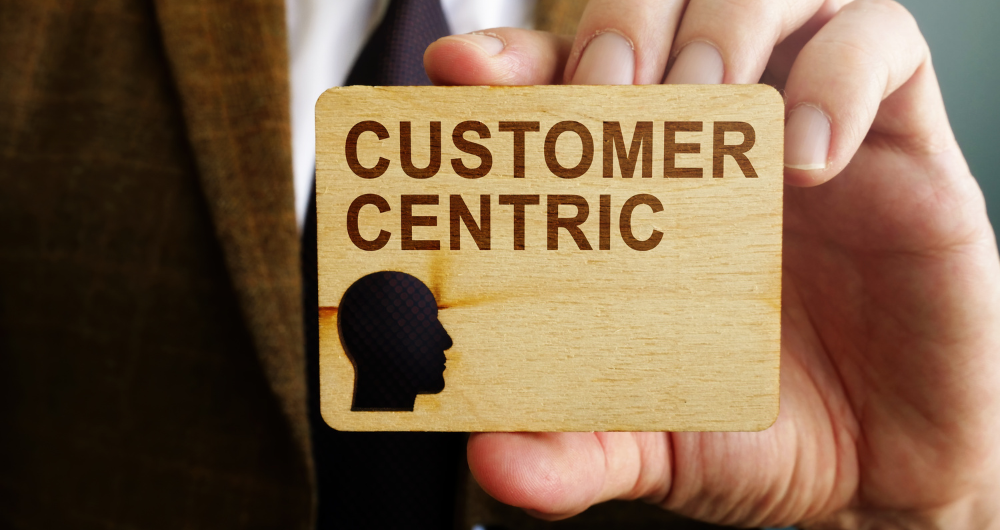
The Rise of Customer-Centric Banking
Customer expectations are reshaping the way banks operate. The era of banks focusing solely on products and services is giving way to a new paradigm—customer-centric banking, where the customer’s needs, preferences, and behaviors take center stage.
This shift is driven by several factors:
- Digital transformation: With digital banking on the rise, customers now expect seamless, personalized, and real-time interactions, available at their fingertips.
- Increased competition: Fintech companies and neobanks are offering more agile, customer-friendly solutions, pushing traditional banks to rethink their strategies to stay relevant.
- Evolving customer expectations: Customers no longer compare banks to other banks; they compare their banking experience to their interactions with top brands in retail, technology, and entertainment.
Adopting a customer-centric approach brings numerous benefits to banks. Personalized services foster deeper emotional connections, leading to stronger customer loyalty. When banks are perceived as partners in their customers’ financial journeys, their brand trust and credibility improve. Furthermore, customer-centric strategies often result in greater cross-selling opportunities and better retention rates, ultimately enhancing profitability.
By putting the customer at the center of their operations, banks are positioning themselves not just to meet current expectations but to anticipate and exceed them.
What is Customer-Centric Banking?
Customer-centric banking refers to a strategic approach where financial institutions prioritize the needs, preferences, and expectations of their customers at every touchpoint. Unlike traditional banking, which focuses on products and services, customer-centric banking is all about creating personalized experiences that resonate with individual customers.
This approach involves delivering tailored experiences based on data insights rather than offering one-size-fits-all products. Customer-centric banks proactively anticipate customer needs and address potential pain points before they escalate into issues, thereby enhancing satisfaction and trust. Furthermore, these banks provide flexible engagement options—whether through mobile apps, in-branch visits, or real-time messaging—to create a seamless experience across all channels.
A key element of this strategy is the effective use of customer data. By leveraging data from various sources—such as transaction history, behavioral patterns, and even geolocation—banks can personalize offers, provide targeted support, and predict future needs. For instance, a bank might offer a personalized loan product to a customer at the right time, based on their financial behavior, instead of sending irrelevant marketing messages.
Additionally, personalization plays a critical role in delivering exceptional customer experiences. Personalization goes beyond using the customer’s name in an email. It involves curating relevant financial products, providing timely alerts, and offering solutions that align with each customer’s life stage, financial goals, and preferences.
This shift toward customer-centricity is about building a lasting relationship with customers by being responsive to their unique circumstances rather than solely promoting a bank’s product portfolio.
Understanding the Customer Journey in Banking

To excel in customer-centric banking, financial institutions need to have a thorough understanding of the customer journey—every interaction a customer has with the bank, from the first point of contact to ongoing service and beyond. Breaking down this journey is key to identifying where banks can deliver more value and optimize the experience.
Key Customer Touchpoints and How Banks Can Deliver Value
Each customer interaction with the bank can be seen as a touchpoint, and at each stage, there are ways to deliver added value. Here’s a combined look at the most important touchpoints and how banks can leverage them to improve the customer experience:
- Awareness: The first interaction a potential customer has with the bank, often through marketing campaigns or word-of-mouth. Banks can deliver value by ensuring their marketing is targeted and relevant, showcasing how their services solve specific customer problems.
- Consideration: At this point, customers are evaluating their options. Banks should provide clear, easy-to-digest information and tools that allow potential customers to compare products. By positioning themselves as transparent and helpful, banks can earn the trust of undecided customers.
- Onboarding: The onboarding process—whether it’s opening an account or subscribing to a service—should be seamless. Banks can deliver value by reducing friction, offering quick account setups, real-time approvals, and clear guidance throughout the process.
- Engagement: Once the customer is actively using the bank’s services, it’s important to maintain engagement through personalized interactions. For example, by leveraging transactional data to offer relevant products, or enhancing off-platform customer interactions, banks can deepen the relationship.
- Support: When customers encounter issues or need assistance, how they are helped becomes critical. Offering multiple support channels, like mobile apps, chatbots, or phone support, ensures customers feel supported and valued.
- Loyalty: Long-term customer relationships are built on consistent, positive experiences. Banks can deliver value by offering personalized rewards, exclusive products, and proactive service that shows appreciation for the customer’s loyalty.
Using Data and Insights to Enhance the Customer Experience
Data is at the heart of delivering a superior customer experience in modern banking. By leveraging customer data and real-time insights, banks can offer more personalized and meaningful interactions at every touchpoint.
- Transactional data: Information on spending habits and account activity can be used to offer relevant products, such as savings accounts, credit lines, or investment options.
- Behavioral insights: By analyzing how customers interact with mobile apps or websites, banks can optimize user experiences. For example, streamlining the features that customers use most frequently or adding new services based on customer feedback.
- Predictive analytics: Banks can anticipate customer needs before they even arise. For instance, recognizing a pattern in increased spending might prompt a bank to offer a credit limit extension or suggest budgeting tools, enhancing the customer’s financial well-being.
- Personalized recommendations: By analyzing individual financial behaviors and preferences, banks can make more accurate product recommendations—such as offering investment options as their savings grow.
In sum, banks that use data effectively can deliver not only personalized offers but also relevant and timely solutions, transforming routine interactions into valuable customer experiences.
Key Strategies for Implementing Customer-Centric Banking
To truly become customer-centric, banks need to implement strategies that prioritize the customer at every interaction. Here are some key approaches that financial institutions can adopt to create a more personalized and responsive banking experience.
Hyper-Personalization of Banking Services
One of the cornerstones of customer-centric banking is hyper-personalization. Offering tailored services based on individual customer behaviors, preferences, and financial situations can significantly enhance the customer experience. Personalization is not just about marketing; it involves delivering the right products, solutions, and support when customers need them most.
Here’s how banks can leverage personalization:
- Behavioral insights: By analyzing transaction histories, spending patterns, and financial goals, banks can provide personalized recommendations for savings accounts, investment opportunities, or loan options that align with the customer’s specific needs.
- Real-time data: Banks that use real-time data to understand customer actions can instantly adjust their offers and suggestions. For example, offering investment advice when an account balance reaches a certain threshold.
- Customer segmentation: Grouping customers based on demographics, spending habits, or life stages allows banks to offer services that are directly relevant to each group, making interactions more meaningful and targeted.
Real-Time Communication and Support
Modern customers expect real-time communication and support that aligns with their fast-paced lifestyles. Banks that can deliver instant updates, notifications, and help can significantly improve customer satisfaction and loyalty.
Ways to enhance real-time communication include:
- Instant notifications: Whether it’s about a transaction, a low balance, or a fraud alert, real-time notifications help keep customers informed and engaged. This not only enhances security but also builds trust.
- 24/7 support: Offering around-the-clock customer support via chatbots, in-app messaging, or live agents ensures that customers can get assistance whenever they need it, reducing frustration and improving their overall experience.
- Real-time decision-making: The use of real-time customer analytics enables the implementation of predictive models, such as Next Best Actions, to guide banks in determining the most effective action to take for each customer.
Seamless Multi-Channel Experiences
Today’s customers interact with their banks across multiple channels—mobile apps, websites, physical branches, and more. A seamless multi-channel experience is crucial for maintaining consistency and ensuring customers receive the same level of service no matter where or how they engage with the bank.
Key considerations for multi-channel banking include:
- Consistent user experience: Whether a customer is visiting a branch, logging into an app, or using the website, the experience should be intuitive and cohesive. Banks can ensure consistency by unifying design elements and features across platforms.
- Data integration across channels: Centralizing customer data allows banks to provide consistent service regardless of the channel. For example, if a customer starts an application in a branch but completes it on the mobile app, the bank should seamlessly carry over the information, avoiding redundant steps.
- Cross-channel functionality: Banks that integrate services across channels offer a more convenient experience. For instance, allowing a customer to schedule an in-branch meeting through the mobile app or offering real-time updates on the status of a transaction regardless of where it was initiated.
Proactive Customer Engagement
Rather than waiting for customers to ask for help, proactive engagement involves anticipating their needs and offering solutions before problems arise. Banks can use predictive analytics and real-time data to reach out with relevant offers, advice, and services.
By leveraging predictive analytics, banks can anticipate customer needs by analyzing data patterns. For example, if a customer’s spending behavior changes significantly, the bank could offer budgeting advice or personalized savings solutions tailored to the new situation.
Additionally, preemptive problem-solving allows banks to address potential issues before they escalate, such as notifying customers about unusual account activity or providing credit monitoring services to prevent security concerns.
Leveraging Technology for Customer-Centric Banking
Technology plays a crucial role in enabling financial institutions to adopt a truly customer-centric approach. By using advanced tools like real-time analytics and decision engines, banks can provide personalized services that not only meet but anticipate customer needs.
Real-Time Analytics and Decision Engines
Real-time analytics is a game changer for banks aiming to offer personalized and timely experiences. By analyzing vast amounts of data in real-time, banks can better understand customer behaviors and needs. This enables banks to offer tailored products and services exactly when the customer is most receptive.
For example, banks can use real-time decision engines to assess a customer’s financial activity as it happens and provide instant recommendations. If a customer is nearing their credit limit, the decision engine might suggest a credit line extension or a customized repayment plan. This proactive support improves the customer experience while also enhancing the bank’s operational efficiency.
Artificial Intelligence and Machine Learning
AI-driven tools help banks automate repetitive processes while providing personalized interactions at scale. For instance, AI-powered chatbots can handle routine customer inquiries in real time, offering support 24/7 without the need for human intervention.
In addition, machine learning algorithms can analyze customer behavior patterns to predict future needs and suggest relevant products. For example, a customer frequently making international transactions might receive targeted offers for a travel credit card or international payment solutions based on their spending habits.
Case Examples of Technology-Driven Customer Engagement
Several banks are already leveraging advanced technologies to create more personalized and customer-focused experiences.
- Wells Fargo: Uses predictive banking to offer personalized financial advice to customers based on their spending habits, income and financial goals. The bank employs sophisticated AI algorithms that analyze a customer’s financial history and current transactions to deliver insights and recommendations in real time.
- BBVA: Uses AI to offer personalized financial advice to its customers through its mobile app, providing insights into their spending and savings habits.
- HSBC: The bank has employed machine learning to detect potential fraud in real time, helping protect customers before any damage is done.
Benefits of Latinia for Customer-Centric Banks
Latinia offers an advanced set of tools specifically designed to optimize banking messaging, ensuring that communications are always timely, relevant and secure, meeting the individual preferences of each customer. Our platform not only improves the interaction between the financial institution and the user, but also ensures the delivery of personalized and context-sensitive messages, strengthening the customer experience.
Each component of Latinia is designed to address the complex operational needs of financial institutions, positioning us as a strategic partner capable of delivering solutions that go beyond real-time analytics.
Allow your customers to choose their communication preferences
The Latinia Subscription Engine enables banks to manage customer communication preferences effectively, ensuring that messages are sent according to each customer’s specific requests.
- Management of customer communication preferences.
- Flexibility in the choice of communication channels and frequency.
- Increased customer satisfaction by respecting individual preferences.
Send relevant and personalized communications to your customers
Latinia NBA (Next Best Action) helps banks provide relevant information and personalized offers based on real-time data and customer behavior. By analyzing transaction history and interaction patterns, Latinia NBA ensures that customers receive timely and relevant messages that enhance their banking experience.
The system leverages real-time transactional events to identify the most appropriate next steps for each customer, providing highly relevant and timely offers and information.
- Personalized messages based on customer data and real-time transactional events.
- Relevant offers and information tailored to individual needs.
- Increased customer engagement and satisfaction.
Ensure delivery of critical communications
Critical messages, such as fraud alerts or important account updates, must always be delivered quickly and reliably. Latinia’s Critical Event Gateway ensures that these vital communications are prioritized and reach customers without delay.
- Reliable delivery of high priority messages.
- Immediate notification of critical events.
- Reduced risk of missing important updates.
Latinia’s Role in Reducing Costs
One of the overlooked advantages of Latinia’s technology is its potential to reduce costs for banks. By managing critical notifications and using multi-provider solutions, Latinia’s platform allows banks to cut down on SMS and notification delivery costs. Furthermore, Latinia’s architecture is scalable and designed to integrate seamlessly with both on-premise and cloud-based systems, helping banks optimize their infrastructure costs while enhancing service delivery.
Conclusion: Building the Future of Customer-Centric Banking
The future of banking lies in the ability to place the customer at the center of every decision, interaction, and service. By adopting a customer-centric approach, banks can not only meet today’s demands but also prepare for the evolving expectations of tomorrow’s customers.
The long-term benefits of customer-centric strategies are clear: deeper customer relationships, higher satisfaction levels, and increased loyalty. These strategies don’t just benefit customers; they also provide banks with new revenue streams through personalized product offerings, cross-selling opportunities, and higher Customer Lifetime Value (CLV).
To stay ahead of the competition, banks must continue to innovate and adapt their customer-centric practices. Technology will play a crucial role in this, particularly in harnessing the power of real-time analytics, AI, and machine learning to deliver hyper-personalized services. As customers increasingly expect seamless, intuitive, and proactive engagement, the banks that excel will be those that leverage these technologies to create meaningful interactions at every touchpoint.
By fostering strong customer relationships, focusing on continuous improvement, and leveraging advanced technology, banks can not only meet customer expectations but exceed them—ensuring long-term success and leadership in the future of financial services.
Ready to redefine your customer interaction strategy? Contact us today to schedule a demo or consult our experts on how Latinia can transform your customer interactions.
Categories: Strategy

